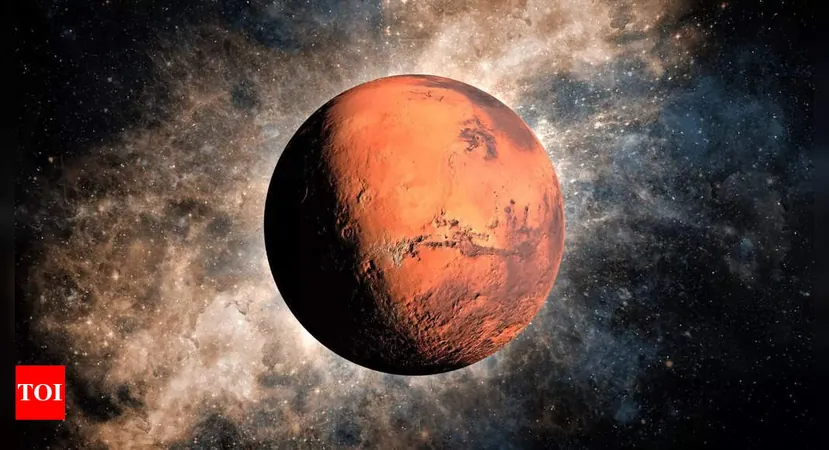
Unveiled! The Shocking Secrets of Mars' Past and Its Clay-Rich Crust
2024-09-27
Author: Rajesh
Mars' Transformation and Atmospheric Decline
Mars, often referred to as the Red Planet, has long been a source of fascination for both scientists and space enthusiasts alike. Once a vibrant world adorned with a rich atmosphere and flowing water, Mars has transformed into the desolate, cold desert we observe today. Researchers have dedicated extensive efforts to unravel the mystery of this atmospheric decline, and a groundbreaking study from the Massachusetts Institute of Technology (MIT) has uncovered some groundbreaking revelations that may change our understanding of the planet’s history.
What Caused Mars' Atmospheric Disappearance?
Experts believe that approximately 3.5 billion years ago, Mars underwent a dramatic transformation. It transitioned from a lush world, abundant in carbon dioxide and liquid water, to a thin atmosphere incapable of sustaining life. For years, scientists have struggled to understand the mechanisms behind this atmospheric loss—until now.
New Discoveries: The Hidden Role of Martian Clay
A team of geologists at MIT posits that answers may lie within the planet’s clay-laden crust. Their latest research, detailed in the journal Science Advances, suggests that Martian clay could harbor substantial amounts of the planet's ancient atmosphere, particularly in the form of methane. "In some ways, Mars's missing atmosphere could be hiding in plain sight," stated Dr. Joshua Murray, a co-author of the study.
The Chemical Magic of Water and Rocks
The team’s research indicates that as water flowed through Martian rocks, it instigated a series of chemical reactions. This process resulted in the conversion of atmospheric carbon dioxide (CO2) into methane, which subsequently became trapped within the clay. Dr. Oliver Jagoutz, the lead researcher, elaborated, "Based on our findings from Earth, we show that similar processes likely operated on Mars, sequestering significant quantities of atmospheric CO2 as methane in clays."
Estimating the Potential of Martian Clay
The study estimates that Martian smectite could potentially contain around 1.7 bar of carbon dioxide—equivalent to about 80% of the planet's original atmosphere. "These smectite clays have vast capacity to store carbon," Dr. Murray emphasized, highlighting the critical importance of their findings.
How Smectite Formed on Mars
Unlike Earth, where tectonic movements contribute to clay formation, the Martian clay developed through a distinct process. The researchers theorized that water interacting with iron-rich minerals like olivine released hydrogen, yielding iron oxide and contributing to Mars's signature red hue. The freed hydrogen then reacted with CO2 to form methane, which gradually morphed into smectite.
Future Implications for Mars Exploration
This pioneering study not only illuminates Mars’s enigmatic past but also sets the stage for future exploratory missions. The prospect of extracting stored methane from Martian clay raises exciting possibilities—it could serve as a valuable fuel source for future missions traveling between Earth and Mars. "This methane could still be present and perhaps be utilized as an energy resource on Mars in the future," noted Jagoutz.
As we continue to probe the mysteries of Mars, these findings may revolutionize our approach to interplanetary exploration. Who knows what other secrets the Red Planet has waiting to be discovered? Keep your eyes on the sky!




 Brasil (PT)
Brasil (PT)
 Canada (EN)
Canada (EN)
 Chile (ES)
Chile (ES)
 Česko (CS)
Česko (CS)
 대한민국 (KO)
대한민국 (KO)
 España (ES)
España (ES)
 France (FR)
France (FR)
 Hong Kong (EN)
Hong Kong (EN)
 Italia (IT)
Italia (IT)
 日本 (JA)
日本 (JA)
 Magyarország (HU)
Magyarország (HU)
 Norge (NO)
Norge (NO)
 Polska (PL)
Polska (PL)
 Schweiz (DE)
Schweiz (DE)
 Singapore (EN)
Singapore (EN)
 Sverige (SV)
Sverige (SV)
 Suomi (FI)
Suomi (FI)
 Türkiye (TR)
Türkiye (TR)
 الإمارات العربية المتحدة (AR)
الإمارات العربية المتحدة (AR)